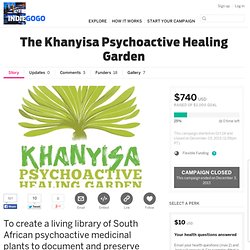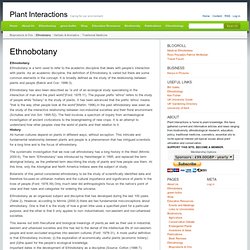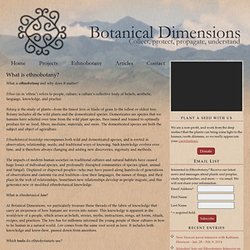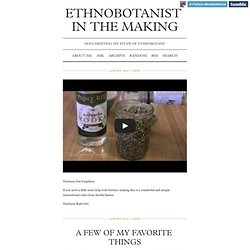

Healing Plants - Grow Healing Plants UK. Ethnomedica: Researching the Herbal Traditions of Britain. PLANT CULTURES - 25 plants to explore. Forget the NSAIDs — Devil’s Claw Beats Arthritis Pain — Studies Prove Efficacy and Safety. The Khanyisa Psychoactive Healing Garden. To create a living library of South African psychoactive medicinal plants to document and preserve their indigenous uses in treating mental illness and disease.

The Khanyisa Psychoactive Healing Garden Project A Better Life through Traditional Knowledge. Aztec use of entheogens. The ancient Aztecs employed a variety of entheogenic plants and animals within their society.

The various species have been identified through their depiction on murals, vases, and other objects. The plants used include ololiuqui (Rivea corymbosa), teonanácatl (Psilocybe spp.), sinicuichi (Heimia salicifolia), toloatzin (Datura spp.), peyotl (Lophophora williamsii) and many others. History[edit] Growing Hermione's Garden. Www.boku.ac.at/biocultural/Material/Innerhofer.pdf. PhD. Chaga Mushroom Science. The “Gift from God” Rather than soft like a mushroom, chaga is hard, almost as hard as wood.

It is unique, nothing like common mushrooms. In fact, chaga is the most nutritionally dense of all tree growths. Known by the Siberians as the “Gift from God” and the “Mushroom of Immortality,” this vibrant growth has been used by humans to support health for thousands of years. The Japanese call it “The Diamond of the Forest,” while the Chinese deem it “King of Plants.” Nutrient dense Chaga is powerful, because it contains the nutrients—the force of actual trees. Ancient Chinese regarded it as a longevity factor. UW-Stevens Point Freckmann Herbarium: Ethnobotany Search. List of ethnobotanists. Scholarspace.manoa.hawaii.edu/bitstream/handle/10125/161/I1547-3465-03-113.pdf?sequence=4. Product Detail. Seed Gallery. BSBI. The Ethnobotanical Garden. Desmanthus. Desmanthus is a genus of flowering plants in the subfamily Mimosoideae of the pea family, Fabaceae.

It contains about 24 species of herbs and shrubs that are sometimes described as being suffruiticose and have bipinnate leaves. Desmanthus is closely related to Leucaena and in appearance is similar to Neptunia. Like Mimosa and Neptunia, Desmanthus species fold their leaves in the evening. They are native to Mexico and North, Central and South America. Description[edit] D. virgatus has a number of common names such as `hedge lucerne' in India, `little mimosa' in Brazil, `bundleflower' in the USA, `leucaena mini' in Indonesia, `dwarf koa', `dais' in Mexico,`donkey bean' and `desmanthus'. The term "donkey bean" comes from Central America where Desmanthus is highly regarded as a fodder for donkeys which are valued domestic draught animals.
In the United States, Illinois bundleflower (Desmanthus illinoensis) is the most widely distributed Desmanthus species. Uses[edit] Species[edit] See also[edit] Ethnomedica: Researching the Herbal Traditions of Britain. Economic Botany Collection - Search. The Encyclopedia of Psychoactive Plants. Sceletium tortuosum. Sceletium tortuosum (Mesembryanthemaceae]) is a succulent herb commonly found in South Africa, which is also known as Kanna, Channa, Kougoed (Kauwgoed/ 'kougoed', prepared from 'fermenting' S. tortuosum[2]) - which literally means, 'chew(able) things' or 'something to chew'.

The plant has been used by South African pastoralists and hunter-gatherers as a mood-altering substance from prehistoric times.[3] The first known written account of the plant's use was in 1662 by Jan van Riebeeck. The traditionally prepared dried Sceletium was often chewed and the saliva swallowed, but it has also been made into gel caps, teas and tinctures.
It has also been used as a snuff and smoked.[4] Effects[edit] Sceletium tortuosum's flower Pharmacology[edit] S. tortuosum has been reported to possess significant mood-elevation and anxiolytic (anti-anxiety) properties.[3][5] S. tortuosum contains about 1–1.5% total alkaloids. Interactions[edit] References[edit] ^ Jump up to: a b "SCELETIUM TORTUOSUM HERBA" (pdf). Meghalaya villagers create 'living' bridges by training roots across a river. By Daily Mail Reporter Updated: 15:35 GMT, 10 September 2011 Deep in the rainforests of the Indian state of Meghalaya, bridges are not built, they’re grown.

Ancient vines and roots of trees stretch horizontally across rivers and streams, creating a solid latticework structure strong enough to be used as a bridge. Ancient solution: The 'double decker' living tree root bridge in the village of Nongriat in Meghalaya, India. Links-Ethnobotany. Recommended Links to the World of Herbs Ethnobotany Note: Each link will open a new browser window.

Close this second window to return to the HRF site. Back to Links page Aboriginal Plant Use in South-Eastern Australia - This web-site contains detailed notes and a bibliography on plants used by Aboriginal peoples of south-eastern Australia. American Indian Ethnobotany - Centre For International Ethnomedicinal Education and Research. Plant Interactions. Ethnobotany Ethnobotany is a term used to refer to the academic discipline that deals with people’s interaction with plants.

As an academic discipline, the definition of Ethnobotany is varied but there are some common elements in the concept. What is ethnobotany? What is ethnobotany and why does it matter?

Ethno (as in ‘ethnic’) refers to people, culture, a culture’s collective body of beliefs, aesthetic, language, knowledge, and practice. Ethnobotanist in the making. The “Folk Method” This is the basic method of preparation of making herbal infused oil by using the “Folk Method”.

(The Herbal Medicine-Maker’s Handbook by James Green) 1. Grind the dry herb down to a find powder. Depending on the size of the batch this can be done in two ways. 2. To make a smaller batch place the powdered herb in a quart mason jar. Tales of a Shaman's Apprentice: An Ethnobotanist Searches for New Medicines in the Rain Forest by Mark J. Plotkin - Reviews, Discussion, Bookclubs, Lists. Unesdoc.unesco.org/images/0014/001458/145847e. TeachEthnobotany. Journal of Medicinal Plants Studies. Home. The personal website of Cassandra L. Quave, PhD. Journal of Ethnobiology and Ethnomedicine.